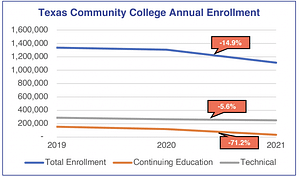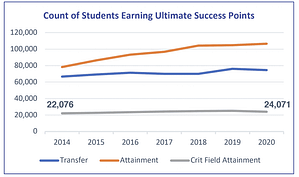With the pandemic impacting the education-to-workforce pipeline, community colleges can help offset these losses by offering post-secondary skilled opportunities
Texas 2036 supports efforts by the Texas Commission on Community College Finance to align the state’s 50 community colleges to meet workforce demands through state-level strategies that pay careful attention to local and regional needs.
Such a strategy would benefit from a focus on improving Texans’ postsecondary education and workforce outcomes through the state’s
community college finance system. We strongly encourage the development of a finance system that meets existing civic demand found through our Texas Voter Polls:
- 87% state that community colleges should focus on programs that match the needs of their local workforce.
- 84% believe that the state must orient its educational programs, degree plans, and certifications towards modern, good-paying jobs.
- 76% want the state legislature to prioritize resources on college and workforce programs that are linked to good-paying jobs.
Texans understand that higher education is necessary for the jobs of today and tomorrow. The pandemic, however, has impacted our education-to-workforce pipeline.
Growth in the percentage of college-ready Texas high school graduates slowed between 2019 and 2020, while percentages of career-ready students fell from 40.4% to 18.7%. Our students are at risk of joining a national student cohort who could lose up to $14.2 trillion of economic activity.
 Community colleges can help offset these losses by providing access to postsecondary skilling opportunities. This will require addressing the consistent decreases in community college enrollment trends.
Community colleges can help offset these losses by providing access to postsecondary skilling opportunities. This will require addressing the consistent decreases in community college enrollment trends.
Technical and continuing education programs are especially important as they tend to be linked to the middle-skills jobs that comprise the majority of all Texas jobs. This is also crucial to attract and grow businesses since, without net migration, Texas faces a talent supply gap of 2.5 million by 2036.
Broader efforts to address long-term workforce needs through Building a Talent Strong Texas (BTST) and the Tri-Agency Workforce Initiative should be leveraged to align the state’s finance system with the state’s postsecondary and workforce goals. BTST and the Tri-Agency’s proposed workforce development goals both call for the increased attainment and completion of Credentials
of Value.
By driving systemic reforms through the state’s community college finance system aimed at helping achieve the state’s goals, the Commission can also meet the demands of Texans and businesses for improved returns on investments. We offer the following data outlining opportunity points for the Commission:

- Student Success Points state funding is only 3.5% of total community college annual operating revenues.
- Ultimate success points (Transfer, Credential Attainment, & Critical Field Credential Attainment) are not connected to wage or employment outcomes, and growth in earned points for these metrics have plateaued.
- State funding for outcomes aligned to workforce needs is only 0.2% of total community college annual operating revenues.
Community College Finance Simulator
Texas 2036 has developed an online, public finance simulator that calculates the state and institutional financial impacts of policy changes to the state’s community college finance system. Currently, the simulator allows users to make modifications to the existing state formulas, such as Contact Hour rates and Success Point metrics.
Texas 2036 will be updating the tool regularly to include variables not currently incorporated in existing state formulas with the goal of serving as a resource to the Commission. The simulator can be accessed at: www.texas2036.org/ccfinance.
